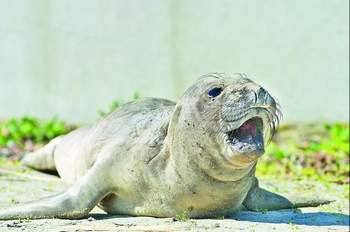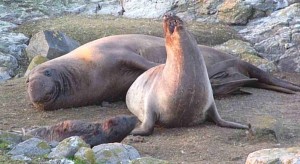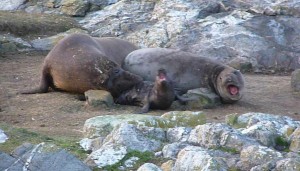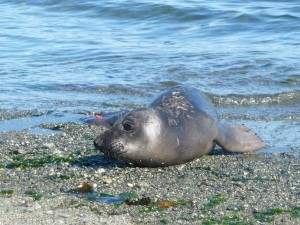Elephant Seal pup on Middle Rocks, January 21, 2010.
|

Elephant Seal pup on Middle Rocks, January 21, 2010.
|
What a pleasant surprize to see little Ninene this afternoon down in front of my home on Taylor Beach on Southern Vancouver Island. She has come through a load of problems and remarkably has made it this far. She was born on Race Rocks on January 30, 2009. Was weaned four weeks later when her mother left, was then badly beaten up by a young aggressive male, who was then driven off by Slash an older male, possibly her father, then she stayed on Race Rocks alone until March 30 without feeding, She then left Race Rocks on March 30, and arrived in Port Angeles on April 7, was moved from downtown to Ediz Hook Coastguard station. and then disappeared the next day. She showed up at 2 and a half months age on Taylor Beach in Metchosin , Southern Vancouver Island. In the past few weeks has traveled well over 50 kilometres.
When she was banded and observed in Washington, several researchers there believed that Ninene did not gain as much weight with her mother as she should have, so she is considered to be underweight for her age. So at this point she still is in a vulnerable situation and we hope she is able to forage well and put on more weight very soon. Ninene stayed only for the day and night. Hse was gone the next day, and we have never seen her since (as of 2014)
This story is reproduced courtesy of the Penninsula Daily News: penninsuladailynews.com
By Rob Ollikainen
Peninsula Daily News
PORT ANGELES — A young elephant seal pup that beached itself on Hollywood Beach last weekend is more than likely a Canadian named Ninene.

A molting female elephant seal lies on the sand at Hollywood Beach in Port Angeles on Monday. Police taped off the area around the seal to keep people from approaching the animal. — Photo by Chris Tucker/Peninsula Daily News
Scientists believe the elephant seal pup that washed up near City Pier is the same seal born Jan. 30 at Race Rocks Marine Ecological Reserve. That seal was named Ninene by researchers at the British Columbia reserve.
The malnourished, scarred female seal was taken from Hollywood Beach — where Olympic Coast National Marine Sanctuary had protected her from onlookers by erecting yellow tape around her on Sunday — to the end of Ediz Hook near the Coast Guard Group/Air Station Port Angeles station on Tuesday to give her more privacy.
She was gone on Wednesday. A sanctuary scientist will check the site today.
Ninene’s life was hard, researchers said. She was weaned early and abandoned by her mother, they said, and was mauled by an adult seal when she was no more than a month old. Bob Steelquist, a spokesman at the Olympic Coast National Marine Sanctuary in Port Angeles, said, “The story gets a little richer.”
Violent childhood
Markings near the seal’s neck — signs of a violent childhood — matched those of Ninene’s, said Garry Fletcher, a volunteer at the Race Rocks reserve. “The pictures sent some evidence of that, and also Race Rocks is only 10 kilometers away,” he said. “As far as we know, we don’t know of any other elephant seals having young ones.” John Barimo, a sanctuary research specialist, said “it makes sense” that the Port Angeles seal and Ninene are one in the same. “It [Race Rocks] is the closest part of Vancouver Island to us, and the timing seems to fit,” Barimo said.
No other elephant seal is known to have been born that far north. Short of conducting a DNA analysis, scientists believe the evidence is sufficient, Barimo said.
Photos of an infant Ninene are available at www.racerocks.com.
Underweight, battered
The 10-week-old seal is severely underweight. She was weaned from her mother when she was 4 or 5 weeks old, Fletcher said. Seals usually are weaned at eight to 10 weeks. “In the first month of its life, it was attacked quite badly by a male,” Fletcher explained.
“We have a series of pictures from when its mother left. It got battered up quite badly.”
At one point, Ninene looked like she was dead, Fletcher said.
Barimo estimated the seal weighed between 100 and 125 pounds when he netted it on Tuesday. Elephant seals that age should weight about 350 pounds, he said.
“Apparently this animal was subject to pretty violent attacks by a young male over there,” Barimo said. “There are signs of the injuries that show up on its neck.” The seal’s current status is unknown. Barimo on Wednesday returned to the site where he released Ninene by the Coast Guard Group/Air Station Port Angles a day earlier. The seal was nowhere to be found.
A Makah scientist had tagged its fin with a number late Tuesday, Barimo said.
Unless Ninene reappears to humans, Barimo said it’s impossible to know if she has recovered or has become “a part of the food chain.”
The most important factor in a seal’s survival is whether or not it can learn to hunt and forage on its own, Barimo said. “It is a tough call,” he said.
“In nature, not everything makes it. . . . If it can learn to fish, it should start bulking up.”
Fletcher said: “She’s gone this far. She certainly over the worst of it.”
Once indigenous to the northwest, elephant seals were hunted out of the area in the late 1880s, Fletcher said.They survived in California and now appear to be on the rebound, Barimo said.”It was a weird twist of fate,” Barimo said.
“It was born next to a helicopter pad, and here we are releasing her at a Coast Guard station by a helicopter pad.”
________
Reporter Rob Ollikainen can be reached at 360-417-3537 or at rob.ollikainen (use the at sign) peninsuladailynews.com.
Last modified: April 09. 2009 11:39PM
This story is reproduced courtesy of the Penninsula Daily News: penninsuladailynews.com
By Rob Ollikainen
Peninsula Daily News
PORT ANGELES — An elephant seal that settled on Hollywood Beach last weekend has moved, but not by choice. For its own protection — and the safety of the general public — scientists from the Olympic Coast National Marine Sanctuary moved the adolescent female seal on Tuesday to the beaches near the Coast Guard Group/Air Station Port Angeles at the end of Ediz Hook. “The decision was based on the seal’s health and the public’s health, both,” marine sanctuary research coordinator Ed Bowlby said. “We’re not sure if it’s molting or if it’s just been weaned from its mother. It’s just now learning to feed for itself.”

John Barimo, left, and Ed Bowlby, right, of the Olympic Coast National Marine Sanctuary, and Bob Campbell of the Fiero Marine Life Center, center, secure a net around a moulting elephant seal on Hollywood Beach in Port Angeles on Tuesday in an attempt to move the animal to a safer location. — Photo by Keith Thorpe/Peninsula Daily News
The decision to move the seal was made by the Northwest Marine Mammal Stranding Network, a division of the National Oceanic and Atmospheric Administration’s Office of Protected Resources, Bowlby said. With about two dozen people looking on, three scientists placed the seal into a net, loaded her into a green Chevrolet minivan and left the City Pier. The cub flapped its paws but didn’t struggle when placed into the net. Its estimated age is between four and six months.
Molting occurs when a seal loses part of its skin and hair, said Bob Steelquist, sanctuary public information officer. The seal had been lying high on the sand between the City Pier and the Crab House Port Angeles Restaurant. Yellow tape separated the seal from curious onlookers. Bowlby said it is uncommon for elephant seals to wash up on Port Angeles shores. “We tend to get more harbor seals,” he said.
Elephant seals are indigenous to the Northwest, but have concentrated in California since their numbers dwindled. Adult elephant seals can dive to depths as great as 4,000 feet in search of fish and squid, Bowlby said. Their populations are recovering, and the species is making a return to the Northwest, Bowlby said.
________
Reporter Rob Ollikainen can be reached at 360-417-3537 or at rob.ollikainen (use the at sign) peninsuladailynews.com.
|
||||||
|
Ryan has observed a lot of aggression on the part of the young male which had previously been named Misery by Mike Slater. |
The baby was born beside the helicopter pad, and has spent the first day there, trying to nurse. The interference by the aggressive male has made this difficult. |
January 30, 2009: This is what we believe is the first elephant seal pup to be born at Race Rocks. It arrived last night or early this morning. See the daily log also for updates. Ryan and Adam have dubbed the pup NINENE, after the WSANEC (Saanich people) moon that it was born under, meaning, child or offspring
Adam Harding took this video at close range from the top of the helipad.The second one was taken on the morning of February 1 from inside of the Marine Centre on Great Race Rocks
In the weeks that followed, Nine went through a In the month following the birth, the pup Ninene, which Ryan observed was a female , went through an incredible amount of trauma while being attacked viciously by the young male Misery. Here we document the process. It is not a pleasant site and at the time of writing, it is still not certain whether this pup will survive. After 4 weeks, weaning took place and the mother left permanently. On the California pupping beaches, the pups normally stay on the pupping grounds often guarded by a male for 5 to 8 weeks longer, without feeding. Then they get hungry and go to the water to feed on their own in shallow protected water . If Ninene makes it that far it will be quite exceptional. Caution: may not be suitable for children.
 |
 |
| Bruises showing on the pup. | Male grasping the pup |
Elephant Seal Male Aggression Videos
The trauma of her first four weeks when she was nursing were minor compared to what happened when her mother left and she was weaned. The young male we have called “Misery” turned on Ninene and beat up on her severely, so much that we considered she was very close to death. Ultimately she was saved by Slash, our old elephant seal, possibly her father, who took on the young male. The following images are not the worst of what we had to watch while this drama unfolded.
On April 7 we were forwarded an e-mail from Dyanna Lambourn, a Marine Mammal Research Biologist, Washington Department of Fish and Wildlife in Lakewood, WA with this picture by Duane Benedict of the Port Angeles Police Department of a Northern Elephant Seal pup that showed up in Port Angeles on April 2nd. She indicates “I suspect it is probably the pup from Race Rocks… I went to the Race Rocks website and it appears that “NINENE” left around that same time. The pup is hauled out in downtown Port Angeles and the plan is to relocate her to the tip of Edis Hook on US Coast Guard Property today. Hopefully the pup will also be tagged.”
Seal pup likely “Canadian born” now she’s missing in the Penninsula Daily News, Port Angeles.
 And then on April 15, 2009, she returns to our shores. The last we see of Ninene with the red tags is on Taylor Beach.
And then on April 15, 2009, she returns to our shores. The last we see of Ninene with the red tags is on Taylor Beach.
|